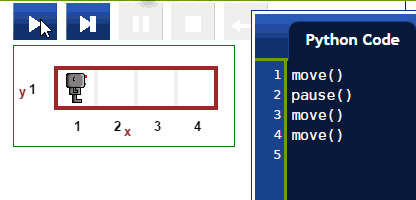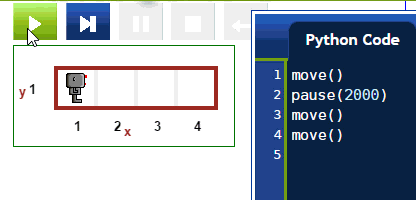A long time ago, when we first talked about bugs, we mentioned the instruction pause(). When Reeborg encounters that instruction, it pauses ... and waits for us to click on a button before moving again.

Actually, the function pause() can take an optional argument, which is the number of milliseconds Reeborg pauses before resuming execution by itself.

Note
A millisecond is one thousandth of a second. This means that it takes 1000 milliseconds to equal one second.
Try it!
Write a program that has Reeborg take various pauses, resuming the execution by itself.
Note
There is a lot going behind the scene to make Reeborg move, pick up objects, etc., and display the updated result on the screen. All this cannot happen instantenously ... but it is usually very fast. Using think() introduces an additional amount of time; by default, this extra time is 250 millisecond (which is one quarter of a second).
So far, excluding the use of pause(), you have written programs where Reeborg execute each step at a steady rate. In a way, it is as though Reeborg thinks for a short while before executing each instruction. Actually, you can control the (additional) time it takes for Reeborg to show the result of any action. To do this, you can use the function think(ms) where ms is an integer argument that represents the (additional) time in millisecond taken by Reeborg to perform any action.
Try this!
Write a program that uses think(ms). You can use think(ms) at many different parts of a program, showing some parts really fast, and slowing down in others by using different values for the ms argument. To have Reeborg move as fast as possible, use think(0).